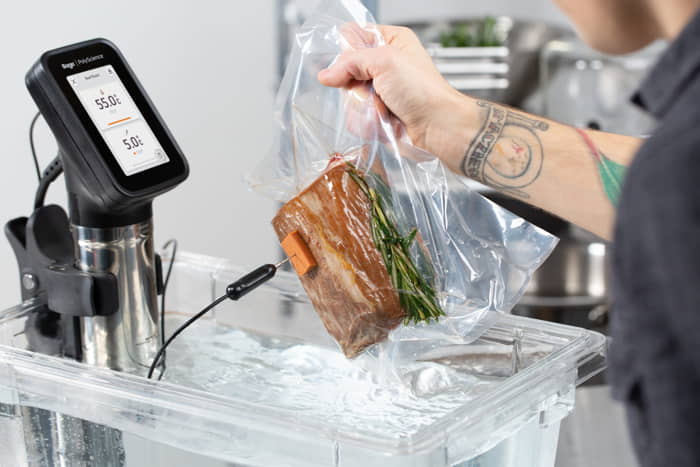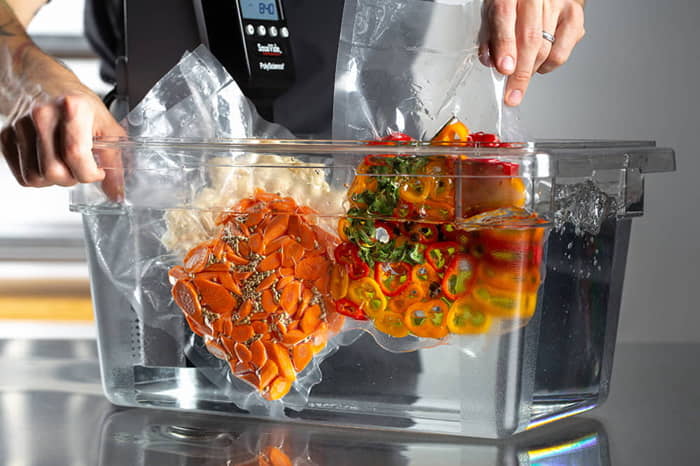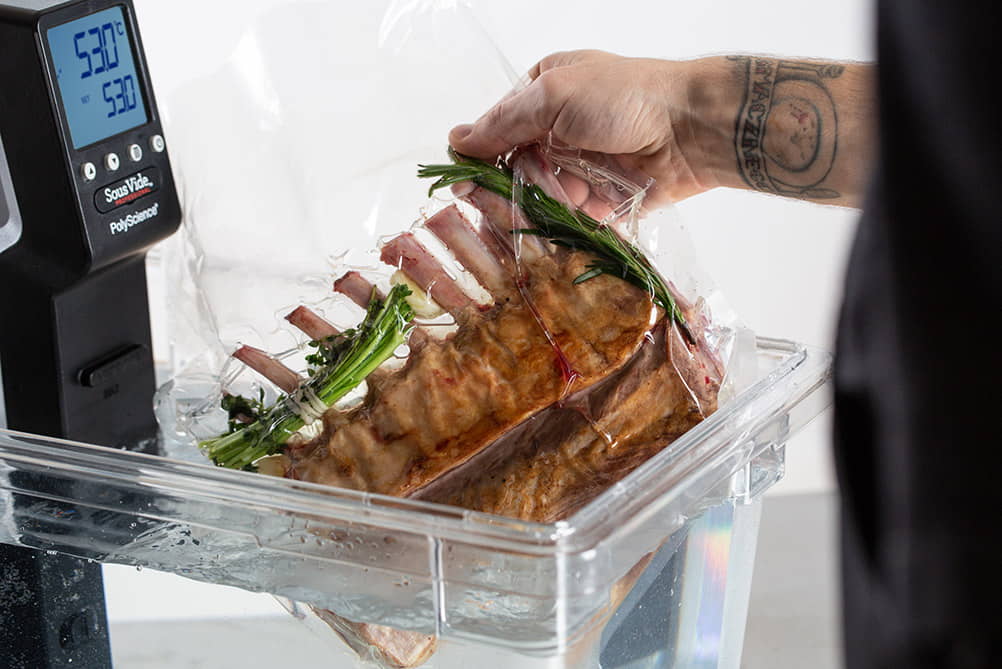
Although it is currently gaining popularity on the menus of the most famous restaurants, this cooking technique -which literally means “in a vacuum”.– was originally used in the early 1970s to minimise product loss when cooking foie gras, and is now adopted by chefs around the world for the preparation of an increasingly wide range of dishes.
The food is vacuum-sealed in a bag and then slowly cooked at gentle, controlled temperatures.
Precise control of the degree of cooking
The correct temperature depends on the type of food. For example, whether it is meat, fish or vegetables. Similarly, it depends on personal taste, e.g., rare or medium rare.
As with all cooking techniques, including microwave, in Sous Vide, the heat penetrates the outer surface of the food and eventually reaches the inside and then heats the center.
The problem arises, for example, if you want a piece of veal undercooked, i.e. veal cooked at 50°C.
It is cooked in an oven at 200°C, and when the center of the meat is at the correct temperature of 50°C, the outside of the meat is overcooked because it has been heated at 200°C for a long time.
On the other hand,if cooked at 50°C, the meat is not overdone, but the heat takes so long to penetrate and raise the temperature that the whole piece dries out.
Or if it is stopped heating too early to prevent it from drying out, the center becomes raw.
With the Sous Vide technique, you cook food at the desired temperature for the whole piece.:no part is overcooked or undercooked; and by sealing the food in a vacuum bag, it does not dry out, lose nutrients or flavor during the long time needed for all the food – inside and out – to cook to the right temperature and therefore to the correct doneness.

Precise temperature control
From a purely functional point of view, cooking is the use of heat to induce chemical reactions, with different effects taking place at different temperatures.
For example, the different proteins in egg albumen coagulate at specific temperatures, and a few degrees difference in cooking temperature will greatly affect the solidification of the egg white.
The texture of the yolk also changes as its temperature increases. Temperature affects meat in a similar way.
Cuts with high collagen content, such as breast and brisket, must be cooked longer and at a higher temperature to properly break down this tough connective tissue. In addition, cuts with little connective tissue (such as rib), may begin to toughen if cooked at these same temperatures.
Just a few degrees can make a difference in a cut of meat, going from tender and moist to tough and stringy.
The art ofSous Vide cooking is to determine the perfect core temperature to achieve the desired flavor and textures. An example might be a dish containing an egg with a creamy, custard-like texture. Well, one chef may cook that egg at a core temperature of 61°C, while another may prefer to cook it at 63°C.
Although this temperature difference may seem insignificant, the eggs will be drastically different from each other, making each chef’s dish unique.
The importance of precise temperature control underscores why Sage PolyScience Sous Vide immersion circulators are essential for sous vide cooking.
Unlike slow cookers on low heat, the immersion thermostat offers extremely precise temperature control, along with set-it-and-forget-it convenience. It can be set to cook food to an extremely precise core temperature – to within a fraction of a degree – with a single adjustment.
Just set the desired temperature, add the food and walk away. Keeping a slow cooker or slow cooker at the right temperature is virtually impossible, and you can’t get repeatable results.
In addition, because they do not circulate the cooking liquid, these appliances can create hot and cold spots that negatively affect the quality of the food. This occurs because heat is transferred 100 times faster in water than in air.
This is why you can reach into an oven and pull out muffins that are at 120°C, but you can’t reach into boiling water, even if it is at the same temperature.
Precise control of professional sous vide cooking time

In addition, the higher the ratio of cooking liquid to food, the faster each portion of food will reach cooking temperature. Sage PolyScience recommends that cooking bags be completely covered with liquid and that there be sufficient space for the bags and cooking liquid to circulate freely.
Another important advantage of slow and low temperature Sous Vide cooking is that it is much more difficult to overcook a dish by carelessly leaving it in longer than necessary. Once the dish reaches the desired temperature, it can be kept at that temperature, moist, delicious and ready to serve, for a longer period of time without shrinking, drying out or hardening.
This is especially advantageous when cooking expensive cuts of meat, such as Kobe/Wagyu beef.
Improve presentation
Enjoying food, whether it’s a quick bite or a multi-course tasting menu at a fine restaurant, is a unique and very personal experience. To be truly satisfying, it must please the senses: sight, smell, taste, touch and even hearing.
Who among us has not had their expectations raised by the artistic presentation, the aroma wafting from the plate or the sizzle of a hot plate of beef, lamb or pork?
To complement and enhance their tenderness, many chefs “finish” Sous Vide meat dishes with a brief pan-cooking, inducing a Maillard reaction, thus creating the well-known aromas and flavours that only come from high-temperature cooking. The fundamental difference with food cooked sous vide and finished this way is that the inside of the food remains exceptionally tender and moist and there is very little of the shrinkage that occurs with traditionally roasted or grilled meat.
Remember that while you cannot overcook a dish with the sous vide method, you can undercook it if you remove it from the hot cooking liquid before it reaches the desired core temperature.
To determine that the desired core temperature has been reached, you can refer to the Sage PolyScience Sous Vide Toolbox, available on Apple iOS.

TÖUFOOD is a complete line of products of exceptional quality, developed by GASTROCULTURA MEDITERRÁNEA SL, which allows the most well-known techniques of modern cuisine to be put into practice. Innovative recipes can be easily realised, bringing excitement and surprise to dishes, offering a stimulating and memorable culinary experience.